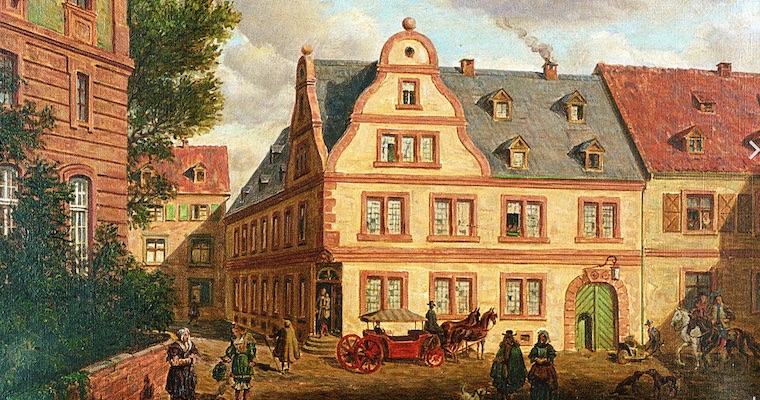What All Family Businesses Can Learn From the Merck Family

The Merck family business dates back to this apothecary, founded in 1668.
The German Merck family has succeeded where many business families have failed: Keeping a group of 319 family members, including 204 family shareholders, unified, aligned and committed over the course of 350 years. Through 13 generations of family ownership, the family has learned what it takes to keep the business in the family for the long haul: Effective business and family governance, strong family relationship, and systematic ownership competence development.[1]
What can others learn from the Merck family? This article offers some key takeaways, as well as questions that family firm leaders can ask themselves.
From Humble Beginnings to Global Importance
When a pharmacist by the name of Friedrich Jacob Merck took over a pharmacy that he later named Engel-Apotheke [Angel Pharmacy] in the small German town of Darmstadt in 1668, he likely did not foresee his small business growing into a global healthcare, life sciences, and performance materials conglomerate. Today, the enterprise generates an annual revenue of 20 Billion Euros (equivalent to $20 billion in August 2022) and employs nearly 61,000 employees in 68 countries.
By the time the family took the company public on the Frankfurt Stock Exchange in 1995, Merck had grown into a rather complex organization with multiple divisions and subsidiaries spread across the globe. The family, driven by a CEO who married into it, decided to fundamentally revisit its organizational and governance structures. The main objectives of the IPO were reducing debt, raising capital, and increasing transparency. When Merck KGaA was formed, it represented the largest public offering in German history, at 2.4 Billion Deutschemarks. After 28 years the Merck family retains a majority interest of 70.3% in Merck KGaA through E. Merck oHG, which operates as a holding company. Given the increased scrutiny this change brought, it was time to revisit the family’s governance system (McQueen, 2020).
Revisiting the Merck Family Governance System
The family views itself as the trustees and owners of the business and not as investors, which shapes their identify as a family shareholder group and how they design their family governance. The Merck family governance system has been – quite literally – centuries in the making, with the first version of their family constitution dating back to 1888. Ever since then the family group has been driven by the question, “How can a structure be devised that is fair, objective and has a buy-in from everyone?”
Governance Bodies
The family governance system rests on two distinct governance bodies to align the family and facilitate decision-making and to effectively manage the interface between the family and the business: The Family Board [Familienrat] and the Board of Partners [Gesellschafterrat].
- The 204 family shareholders elect the 13 members of the family board every five years. The primary responsibility of the family board is to represent the family interests in the business and to maintain strategic oversight of the business (e.g., any acquisitions, divestments, or financial transactions above half a billion Euros require the approval of the family board). The family board meets up to 10 times a year.
- The family board nominates five of its members for the board of partners, which acts as a supervisory board for the executive management team and exercises daily operational control over the business. These family representatives play a crucial role in ensuring that the family’s strategies align with its long-term vision. The board of partners counts nine members in total; five are family members and four are independent experts.
The heads of the family board and the board of partners lead as a diarchy. The head of the family board is the official head of the Merck family and acts as a link between the family, the business, and the public, and as a liaison to all family members.
This dual structure, established 20 years ago, allows the family board to make quick and efficient business decisions. The only decision-making tasks remaining with the family assembly are the election of family members to the family board, as well as changes to the family constitution.
Governance Documents
The family constitution supplements these formal decision-making governance bodies. The family constitution clarifies the family shareholders’ rights and responsibilities as trustees of the family enterprise. The family has a process in place to revise the constitution continually to make sure that it reflects the changes in the family, the law and in the wider society.
The constitution also clarifies when and how family members can exit. Every 10 years, the duration of the constitution is extended by another 10 years to a total of 30 years. Family shareholders can sell their equity participation to another family member at a discount of 20% of the market value of the shares of the listed entity at any time, or they can give notice to leave the company as partners at the end of a 30-year period.
Informal Governance
In addition to the formal governance mechanisms, the family also relies on informal governance, aimed at building strong relationships and actively living the values. The Merck family realized early on that without strong family relationships, the family was in danger of falling apart in time. They regularly create opportunities to spend time together both socially (as a family) and formally (in the context of the business). In addition to the annual general meeting, the family meets for a second time every two years.
Consistently living their values is another important pillar of Merck’s informal family governance. One such important value is modesty: “The family is opposed to displays of material wealth.” Ensuring that family members understand and embody the family’s core values is an important step in ensuring family cohesion and alignment (Stangenberg-Haverkamp 2019a, 2019b).
Question for Readers: Is your family governance system designed to help your family become the family you want it to be, or does it keep you stuck where you are?
Developing Competent Owners for a Thriving Legacy
The Merck family dedicates significant resources towards developing ownership competence, which ensures that family shareholders can make good decisions for the business and the family. Merck has a sophisticated ownership development program that begins at an early age and covers multiple areas, from company-specific knowledge to general business skills, interpersonal abilities, and knowledge about family dynamics and the family history. Their educational program relies on nine building blocks that support three objectives: (1) familiarizing the next generation with the key topics of the business and family governance, (2) generating a pool of interested and competent family members who may decide to engage in one of the family governance boards or activities, and (3) ensuring family members have ample opportunities to connect and engage with one another, thereby ensuring the growing ownership group remains aligned over time (Stangenberg-Haverkamp, 2019a, 2019b).
- Two next-generation programs for family members aged 15–23 and 24–35 are offered every year. These programs last 2 1/2 days and focus on business and family. On the business side, children and young adults learn about, for example, the different business areas, the business strategy, innovation strategy, or digitalization strategy. On the family side, they learn about the family constitution, governance structure, and family history.
- On several occasions each year, “fireplace chats” are organized in different German cities that family members and spouses can attend freely. These events provide an informal way to discuss business matters of interest without an agenda, and to get to know one another.
- Every two years, family members can participate in “family bonds,” a two-day peer-to-peer learning event where representatives of six large German business families meet and exchange best practices in managing and meeting the demands of a growing business family.
- The “business family academy” is offered by Witten/Herdecke University. Members of the Merck family can participate and receive funding from the family to do so. The program focuses on different issues relevant to members of business-owning families, usually in two-day segments.
- The Merck Family University is designed for family members who want to learn more about the company and its business and are considering joining the family board or the board of partners. Participants attend five modules that last 1 1/2 to 3 days each. The whole program takes 12 months to complete and covered both Merck-specific and general business topics. The family offers the Merck University to interested family members before the family board election every five years.
- Voluntary family assessments are offered for all family members who consider participating in a governance role. The assessment is done by an external service provider, who then recommends customized educational activities for each family member.
- The annual “Merck Family Day” is open to all family members and takes place at a hotel near company headquarters. The moderated day centers around business highlights, peer-to-peer learning and lots of family interaction.
- The annual family shareholder assembly aims to inform the family shareholder group about recent developments in the business – similar to an annual shareholder's meeting of a public company. It is also used to prepare family shareholders for any potential upcoming big business decisions.
Question for Readers: What do you currently do to develop ownership competency among family shareholders in your family? Who has access to these educational activities? How do you measure success?
What Others Can Learn from the Merck Family
Merck’s family governance system rests on the belief that only informed owners can be capable of making and supporting good decisions that acknowledge the reality and constraints of the business, and remain aligned with the family values and objectives. This is why the family dedicates significant resources to ensure that family members not only have access to relevant information, but also develop the ability to make informed decisions together. Research has shown that families benefit from investing in these capabilities at an earlier stage and for smaller groups, as it sets a strong foundation for building ownership unity, alignment, and actionability.
What can we learn from the case?
- Prioritize family unity. The family offers its members many opportunities to connect and spend time together. This helps strengthen the fabric of family, promote trust, and thereby facilitate decision-making.
- Be strategic and systematic about ownership development. The Merck family offers a systematic way for family members to become knowledgeable and committed trustees of the family enterprise, starting from a young age.
- Make your family governance agile. The Merck family regularly updates their family constitution to ensure it continues to fit the family circumstances. This holds true for all governance mechanisms. Make sure that any formal governance structures you put in place support you in becoming the family you want to be five or 10 years from now – and not stuck in the present.
Question for Readers: Do you have a strategy, and specific measures in place, to keep the family engaged, unified, and aligned for the long term? What might you do to enhance your efforts?
References
Binz Astrachan, C. & Botero, I. (2021). Business Family Governance 2.0: Leveraging Business Family Governance for Family Business Continuity. IFBRF Research Report.
McQueen, J. (2020). MERCK: Thinking in generations, not just in quarters. Available at: https://cmgpartners.ca Accessed: June 12, 2021)
Stangenberg-Haverkamp, F. (2019a). Family Business Governance Rooted in Values: The Case of Merck, Darmstadt. Available at: https://isbinsight.isb.edu/the-case-of-merck-darmstadt (Accessed: June 11, 2021)
Stangenberg-Haverkamp, F. (2019b). 350 Years of Family Business: Lessons from Merck. Available at: https://isbinsight.isb.edu/350-years-of-family-business-lessons-from-merck (Accessed: June 11, 2021)
Rüsen, T. A., Stangenberg-Haverkamp, F. (2020). Familienmanagement im Hause Merck: Ansätze und Maßnahmen zur Entwicklung von Gesellschafterkompetenz. In: Rüsen, T. A., Heider, A. (Hrsg.). Aktive Eigentümerschaft im Familienunternehmen. Gesellschafterkompetenz in Unternehmerfamilien entwickeln und anwenden (S. 393–398). Berlin: Erich Schmidt.
[1] This case study is a modified excerpt from the Research Report ‘Family Business Governance 2.0’ by Binz Astrachan and Botero (2021), commissioned by the Institute for Family Business UK Research Foundation and is based on the Merck Case study on ownership competency development by Rüsen and Stangenberg-Haverkamp (2020).


Head of Governance Practice at Generation 6 | Family Enterprise Advisors / Lucerne School of Business / Affiliated Researcher at Jönköping University (CeFEO) and Witten/Herdecke University
View Profile




